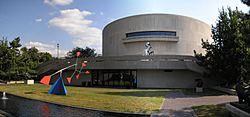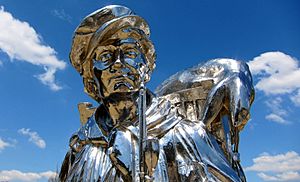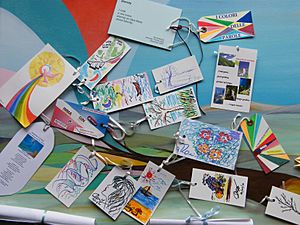Hirshhorn Museum and Sculpture Garden facts for kids
 |
|
 |
|
| Established | 1974 |
|---|---|
| Location | Washington, D.C., on the National Mall |
| Type | Art museum |
| Visitors | 828,949 (2022) |
| Public transit access | |
The Hirshhorn Museum and Sculpture Garden is a cool art museum located right next to the National Mall in Washington, D.C., in the United States. It's famous for its collection of contemporary and modern art, especially art made after World War II.
The museum was started in the 1960s with a huge art collection from a man named Joseph H. Hirshhorn. It was designed by a famous architect named Gordon Bunshaft. The Hirshhorn is part of the Smithsonian Institution, which runs many museums in Washington, D.C.
The building itself is very unique! It looks like a big, round cylinder that stands on four large "legs." In the middle of the building, there's a big fountain in a courtyard.
Contents
History of the Hirshhorn Museum
How the Museum Started
Back in the late 1930s, the United States government decided that the National Mall needed a new art museum. At that time, the main art museum, the National Gallery of Art, mostly showed older European art. The idea for a new museum was put on hold during World War II.
Meanwhile, a man named Joseph H. Hirshhorn was becoming very successful in the uranium mining business. He started collecting art when he was in his forties. His collection grew to include everything from classic French Impressionism to modern art by living artists. By 1955, he sold his uranium businesses and had even more money to buy art. His collection became so big that he needed warehouses, an apartment in New York City, and a large estate in Connecticut just to store it all!
In 1962, a special art show at the Guggenheim Museum in New York showed the world how amazing Hirshhorn's sculpture collection was. Other museums from different countries wanted his collection. But President Lyndon B. Johnson and Smithsonian Secretary S. Dillon Ripley worked hard to get the collection for a new museum on the National Mall.
In 1966, a special law was passed by Congress to create the Hirshhorn Museum and Sculpture Garden. Most of the money for building it came from the government, but Joseph Hirshhorn also gave $1 million. The museum officially started being built in 1969.
When the museum opened in 1974, Joseph Hirshhorn gave a speech. He said that he was honored to give his art collection to the people of the United States. He felt it was a way to thank the country for what it had done for him and other immigrants. In the first six months, one million visitors came to see the museum's first show!
Museum Leaders Over Time

After the first director, Abram Lerner, retired, other leaders took charge of the Hirshhorn. James T. Demetrion became director in 1984 and stayed for over 17 years.
Later, Ned Rifkin, who had worked at the Hirshhorn before, became director in 2002. In 2005, Olga Viso became the director. She had worked at the Hirshhorn for many years before becoming its leader.
In 2009, Richard Koshalek became the fifth director. He was known for working with famous architects like Frank Gehry and Arata Isozaki on other museum projects. He resigned in 2013 after a disagreement about a new building project, which we'll talk about next.
On June 5, 2014, Melissa Chiu was chosen as the new director. She was born in Australia and is an expert in Chinese art. She started her job in September 2014 and helped the Hirshhorn celebrate its 40th anniversary that fall.
Amazing Art Collection
The Hirshhorn Museum has many famous artists in its collection. Some of these include Pablo Picasso, Henri Matisse, Jackson Pollock, Mark Rothko, and Willem de Kooning.
Outside the museum, in the sculpture garden, you can see works by artists like Auguste Rodin, David Smith, Alexander Calder, and Jeff Koons.
A special artwork called Wish Tree for Washington, DC by Yoko Ono has been in the Sculpture Garden since 2007. People can write wishes on cards and hang them on the tree. Wishes now come from all over the world!
In 2019, the museum received a huge gift: the entire Marcel Duchamp collection from Barbara and Aaron Levine. It's one of the biggest collections of his work in the world.
The "Bloomberg Bubble" Idea
In 2009, the museum's director at the time, Richard Koshalek, announced a plan for a new, temporary structure. It was going to be a giant inflatable building over the museum's central courtyard. They called it the "Bloomberg Bubble."
The idea was to inflate this bubble once a year for two months. It would create a huge space for performances and talks. The design for the Bubble even won an award!
However, the project ran into problems. The estimated cost to build the Bubble went from $5 million to $15.5 million, which was much more than expected. Also, the museum didn't get enough donations to pay for it. Because of these issues, the museum decided not to go ahead with the "Bloomberg Bubble" project.
Museum Building and Design
The Hirshhorn Museum was designed by architect Gordon Bunshaft. The building has about 60,000 square feet of space for art inside. Outside, the Sculpture Garden covers almost four acres. People have described the building as a "fortress" that works well as a museum.
The building is round, about 231 feet across. The inner courtyard is 115 feet across, and the fountain in the middle is 60 feet wide. The building itself is 82 feet tall and stands 14 feet off the ground on its four large legs.
The museum has three floors for showing art. There's also a 274-seat auditorium on the lower level. The Sculpture Garden is a bit lower than the street, about 6 to 14 feet down, and has ramps so everyone can visit.
Building Changes Over Time
- 1969: Construction began on the Hirshhorn Museum. Some people were concerned about naming a museum on the historic National Mall after a living person. They also worried about the museum's modern look.
- 1971: The original plan for the Sculpture Garden was changed. It was made smaller and moved to be parallel with the Mall instead of crossing it. The design was kept simple to make the artworks stand out.
- 1974: The museum opened with its art galleries, fountain plaza, and Sculpture Garden.
- 1981: The Sculpture Garden was updated by a landscape architect named Lester Collins. He added plants, paved paths, and grassy areas to make it more welcoming.
- 1993: The area around and under the museum building, called the Plaza, was renovated. New paving and trees were added.
- 2021: Big restoration work started on the outside of the building. The National Capital Planning Commission also approved a new design for the Sculpture Garden by artist Hiroshi Sugimoto. This new design will allow people to go underground from the Sculpture Garden into the museum building.
Museum Visitors
In 2019, about 890,000 people visited the Hirshhorn Museum. However, in 2020, the number of visitors dropped a lot because of the COVID-19 pandemic. The museum was closed from March 2020 until August 2021. In 2020, only about 133,000 people visited, and in 2021, about 167,000 visited. By 2022, the number of visitors had increased to 828,949.
See also
 In Spanish: Museo Hirshhorn y Jardín de Esculturas para niños
In Spanish: Museo Hirshhorn y Jardín de Esculturas para niños
Artworks in the Collection
- Eros, Inside Eros by Arman
- Monsoon Drift by Anthony Caro
- The Drummer by Barry Flanagan
- Large Hybrid by Richard Hunt
- Kiepenkerl by Jeff Koons
- Brushstroke by Roy Lichtenstein
- King and Queen by Henry Moore
- Last Conversation Piece by Juan Muñoz
- Antipodes by Jim Sanborn
- Post-Balzac by Judith Shea
- Needle Tower by Kenneth Snelson
- Cubi XXVI by David Smith
- Throwback by Tony Smith
- Are Years What? (for Marianne Moore) by Mark di Suvero
- Geometric Mouse, Variation I, Scale A by Claes Oldenburg
- Sphere Within Sphere by Arnaldo Pomodoro
- The Burghers of Calais by Auguste Rodin
Other Related Topics
- DC Environmental Film Festival
- National Gallery of Art Sculpture Garden
- Architecture of Washington, D.C.
Images for kids
-
The Burghers of Calais by Auguste Rodin (1889)
















